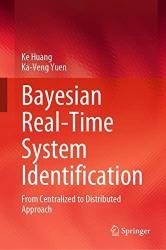Bayesian Real-Time System Identification: From Centralized to Distributed Approach
- Добавил: literator
- Дата: 23-03-2023, 06:03
- Комментариев: 0
 Название: Bayesian Real-Time System Identification: From Centralized to Distributed Approach
Название: Bayesian Real-Time System Identification: From Centralized to Distributed ApproachАвтор: Ke Huang, Ka-Veng Yuen
Издательство: Springer
Год: 2023
Страниц: 286
Язык: английский
Формат: pdf (true)
Размер: 13.5 MB
System identification aims at estimating the physical parameters associated with a mathematical model from measured data. It is applicable to virtually all areas of science and engineering. Any discipline concerned with mathematical modeling of its underlying system is a likely candidate for system identification. This includes statistical physics, information sciences, chemical engineering, electrical engineering, etc. Real-time system identification provides comprehensive treatment for the challenging issue in dynamical systems: tracking time-varying systems. It is desirable for promptly acquiring information from the system for monitoring and control purposes.
This book aims to provide novel identification insights for dealing with some challenging identification problems for time-varying dynamical systems. It offers two different perspectives to data processing for system identification, namely, centralized and distributed, compared with conventional centralized approaches. Centralized identification requires transmitting all measured data to a single processing unit. A number of methods for parameter estimation have been developed in this scope under different working conditions. Real-time model class selection is also considered and it is incorporated with parameter estimation for system identification purposes. Traditionally, there are two levels of system identification problems, i.e., estimation of the uncertain parameters governed in the mathematical model and selection of an appropriate model class representing the underlying dynamical system. However, in terms of model class selection, there is no guarantee of satisfactory modeling results since all the model class candidates may be unsuitable. A new third level of system identification using self-calibratable model classes will be introduced. The structure of the model classes can be adaptively modified. On the other hand, distributed identification takes advantage of wireless sensing, data acquisition, and computational technology so that the computational workload can be outsourced and distributed to the sensor nodes. Then, the obtained local results are fused at the central station to provide the global interpretation of the underlying system. Methods are also developed based on the distributed identification framework using data of different natures, including asynchronous data and multiple outlier corrupted data.
This book presents the applications for Bayesian real-time system identification to enrich practical engineering scenarios. Although the application context mainly focuses on civil engineering infrastructures, the presented theories and algorithms are widely applicable for general dynamical systems (such as mechanical systems and aerospace structures). This book provides sufficient background to follow Bayesian methods for solving real-time system identification problems in civil and other engineering disciplines.
Contents:
Скачать Bayesian Real-Time System Identification: From Centralized to Distributed Approach
[related-news] [/related-news]
Внимание
Уважаемый посетитель, Вы зашли на сайт как незарегистрированный пользователь.
Мы рекомендуем Вам зарегистрироваться либо войти на сайт под своим именем.
Уважаемый посетитель, Вы зашли на сайт как незарегистрированный пользователь.
Мы рекомендуем Вам зарегистрироваться либо войти на сайт под своим именем.

